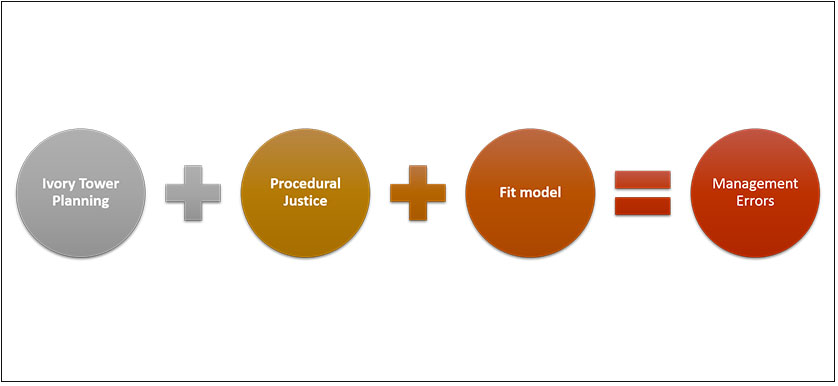When management fails: Turning error into performance
When discussing about management errors, Eleanor Roosevelt said it best: “Learn from the mistakes of others. You can’t live long enough to make them all yourself. ” If we analyze the decision making process in companies all over the world, we find that mistakes are common, but what makes the difference between an excellent and an average manager, is the ability to find solutions for errors and learn from others’ mistakes. Taking these aspects into consideration, we will discuss three main management errors that can occur during the decision process:
1. Ivory Tower Planning
Ivory tower planning is usually associated with the use of formal planning. When designing a strategy plan, or taking an important decision which will shift the direction of the company, the management team ignores the potential contribution and value that may stem from any employee’s input. This approach can lead to companies having strategic plans designed by managers who have little understanding of the company’s reality, processes or customers. This separation between managers and employees will result in causing the company more harm than good.
An example of ivory tower planning can be seen at General Electric: When the demographic data indicated that house spacing has decreased in square footage, GE’s appliance group established that smaller appliances will be the next trend. They had little contact with homebuilders and retailers, missing the fact that kitchens and bathrooms were the only rooms that maintained their dimensions. Also, they didn’t notice that working couples wanted bigger refrigerators to cut down on number of trips to the supermarket. In the end GE wasted a lot of time and money designing small appliances with limited demand.
Solution: When designing the strategic plan, employees at all levels in the company should be involved. More specifically, when a company is doing the internal analysis, key employees in all areas of the company should offer their inputs regarding what should be the next steps for the organization. In this equation, the top managers should act as facilitators.
2. Procedural Justice
Procedural justicerefers to the managers’ decision making process, when they make decisions based on what they believe is fair. Procedural justice can be seen as positive when it is done internally, for example when evaluating employees. But, in the designing the strategy plan, procedural justice is seen as a barrier, because it clouds the strategy manager’s judgment, as he views the company’s opportunities and threats only form the point of his beliefs.
An example of procedural justice can include companies that produce children’s games or toys. This kind of companies are not really cutting edge in terms of completion and their managers tend to make decisions that are oriented towards procedural justice. This can affect the firm’s profitability.
Solution: The strategic manager and/or the top managers who are responsible with the decision making process should not fundament the decisions on their own personal beliefs of what is fair or not, but the process should be based on what is important for the company.
3. Fit model
The fit model represents a model where a company limits its ability to expand, by focusing too much on the existing resources and current environmental opportunities, and not enough on building new resources and capabilities to create and exploit future opportunities.
An example might be when top managers in an organization do not comprehend what is the maximum potential of their resources, so they won’t design a strategy to use the available resources for exploiting other opportunities.
Solution: When designing the strategy plan, managers should have a clear understanding about the internal resources and the company’s opportunities. A tool that can be used for internal analysis can be the SWOT or Value chain analyses, along with Porter’s 5 forces model or PESTEL for the external environment.
Mistakes and errors are part of the daily activities in a company. Gathering insights from others’ mistakes and learning how to control such impediments, so they won’t reappear, is part of every manager’s job. This will lead to the success of the company and, most probably, to an increase in revenues.
References:
- Hill, C. and Jones, G. (2012), Essential of strategic management, third edition, South-Western, Cengage Learning
- Chelladurai, P. (2006), Human resource management in sport and recreation, second edition, Packianathan Chelladurai, United States of America
- Houghton Mifflin Company (n.d.), The Strategic Management Process

Tags: Knowledge Management, Mistakes





